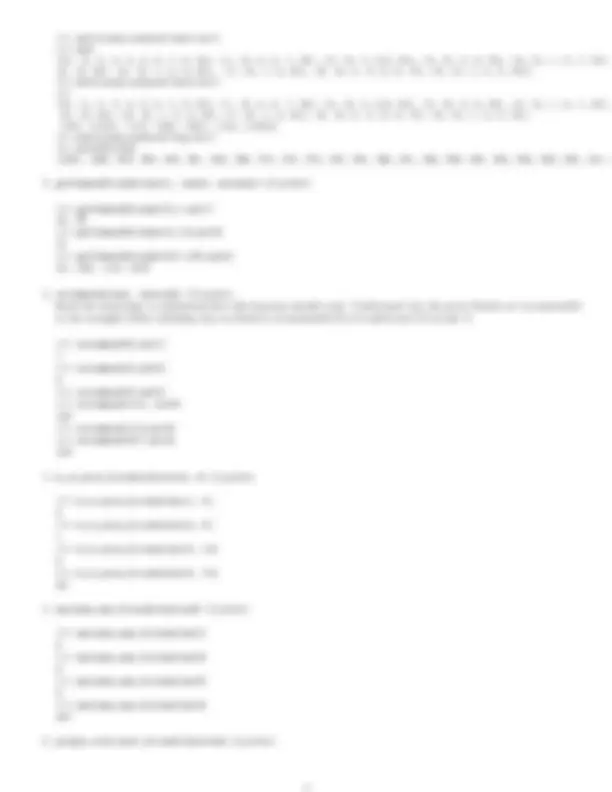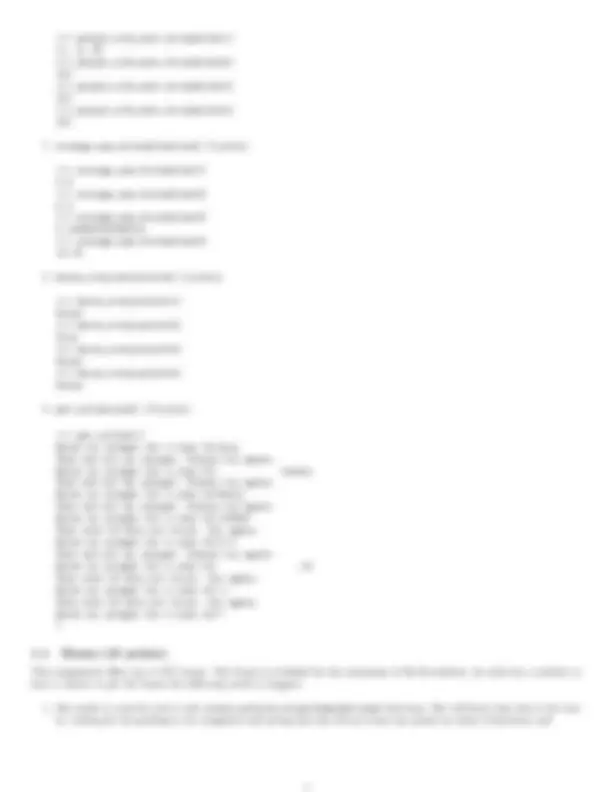





Study with the several resources on Docsity

Earn points by helping other students or get them with a premium plan


Prepare for your exams
Study with the several resources on Docsity

Earn points to download
Earn points by helping other students or get them with a premium plan
Community
Ask the community for help and clear up your study doubts
Discover the best universities in your country according to Docsity users
Free resources
Download our free guides on studying techniques, anxiety management strategies, and thesis advice from Docsity tutors
Python assignment 4 for ITI1120. Vida Dujmovic is the teacher.
Typology: Study Guides, Projects, Research
1 / 5

This page cannot be seen from the preview
Don't miss anything!




Note
Read the instructions carefully and follow them exactly
Assignment Weight
As outlined in the syllabus, this assignment is worth 5% of your final grade
Due Date
This assignment is due 8am on Monday, Nov 20, 2017
Important
As outlined in the syllabus, late submissions will not be accepted. Any Python files with syntax errors will automatically be excluded from grading. Be sure to test your code before you submit it. For all functions, make sure you’ve written good docstrings that include type contract, function description and the preconditions if any. This is an individual assignment. Please review the Plagiarism and Academic Integrity policy presented in the first class, i.e. read in detail pages 15 − 19 of course outline. You can find that file on Brightspace under Course Information. While at it, also review Course Policies on pages 13 and 14.
The goal of this assignment is to learn and practice the concepts covered thus far. In particular you will get more practice with (2D) lists and functions. For one of the functions you will also need to learn how to prevent syntax errors i.e. crashes by learning about try/except concept for handling exceptions. Given the goals of this assignment, you cannot user: dictionaries, sets, deque, bisect module. You can though, and in fact should, use .sort or sorted functions. As always, you can make multiple submissions, but only the last submission before the deadline will be graded. For this assignment, you only need to submit one file, called a4_xxxxxx.py, where you changed xxxxxx to your student number. (No need to submit a4_xxxxxx.txt as proof that you tested your function. By now we trust that you learnt and understand the need and importance for testing your functions and code in general). For this assignment, I provided you with starter code in file called a4_xxxxxx.py. Begin by replacing xxxxxx in the file name with your student number. Then open the file. Your solution (code) for the assignment must go into that file in the clearly indicated spaces. The file has main completely coded for you. Nothing else will go into the mail. It also has some functions completely precoded for you. Your task will me to code the remaining functions. You are not allowed to delete or comment-out any parts of the provided code. The only exception to that rule is the keyword pass. Some functions have that keyword. You can remove it once you are done coding that function. You also must follow the instructions given in comments and implied by docstrings. You are however allowed to add your own additional (helper) functions. In, fact you should add at least one more function. I have provided 5 text files to test and debug your code with as explained in the next section. As always, your program must run without syntax errors. In particular, when grading your assignment, TAs will first open your file a4_xxxxxx.py with IDLE and press Run Module. If pressing Run Module causes any syntax error, the grade for the assignment becomes zero. Furthermore, for each function whose code is missing, I have provided below one or more tests to test your functions with. To obtain a partial mark for these function your solutions may not necessarily give the correct answer on these tests. But if your function gives any kind of Python error when run on the tests provided, that function will be marked with zero points. Finally, each function has to be documented with docstrings. There is also a4-more-example-runs.txt file, giving additional example runs to those given in the next section. The behaviour of all example runs below and in a4-more-example-runs.txt should be considered as an implied requirement for the assignment – as always. Using global variables inside of functions is not allowed. If you do not know what that means, for now, interpret this to mean that inside of your functions you can only use variables that are created in that function. For example, the following code fragment would not be allowed, since variable x is not a parameter of function a_times(a) nor is it a variable created in function a_times(a). It is a global variable created outside of all functions.
def a_times(a): result=x*a return result
x=float(input("Give me a number: ")) print(a_times(10))
Have you ever wondered how social networks, such as Facebook, recommend friends to you? Most of the social networks use highly sophisticated algorithms for this, but for this assignment you will implement a fairly naive algorithm to recommend the most likely new friend to users of a social network. In particular, you will recommend the most probable user to befriend based upon the intersection of your common friends. In other words, the user that you will suggest to Person A is the person who has the most friends in common with Person A, but who currently is not friends with Person A. Five text files have been provided for you to run your program with. Each represents a social network. Three are small test files containing a made-up set of users and their friendships (these files are net1.txt, net2.txt and net3.txt). The two are a subset of a real Facebook dataset, which was obtained from: fhttps://snap.stanford.edu/data/egonets-Facebook.html The format of all five files is the same: The first line of the file is an integer representing the number of users in the given network. The following lines are of the form: user_u user_v where user_u and user_v are the (non-negative integer) IDs of two users who are friends. In addition user_u is always less than user_v For example, here is a very small file that has 5 users in the social network: 5 0 1 1 2 1 8 2 3 The above is a representation of a social network that contains 5 users. User ID=0 is friends with User IDs = 1 User ID=1 is friends with User IDs = 0, 2, 8 User ID=2 is friends with User IDs = 1, 3 User ID=3 is friends with User IDs = 2 User ID=8 is friends with User IDs = 1
Spend time studying the above small example to understand the model. For example, notice that since friendship is a symmetric relationship the social media networks in this assignment, if user_u is friends with user_v, that means that user_v is also friends with user_u. Such “duplicate” friendships are not present in the file. In particular each friendship is listed once in such way that user_u < user_v
Also note that, while you can assume that user IDs are sorted, you cannot assume that they are consecutive integers differing by one. For example the user IDs above are: 0,1,2,3,8. You can also assume that in each file the users are sorted from smallest to largest (in the above example you see that users appear as: 0 1 1 2). Specifically, friendships of user_u appear before friendships of user_v if and only if user_u < user_v. And also for each user its friends appear sorted, for example for user 1 friendship with friend 2 appears before friendship with friend 4. To complete the assignment you will have to code the following 9 functions. I strongly recommend you code the in the order given below and do not move onto coding a function until you complete all before. The function descriptions, including what they need to do, are given in a4_xxxxxx.py.
net1=create_network("net1.txt") net [(0, [1, 2, 3]), (1, [0, 4, 6, 7, 9]), (2, [0, 3, 6, 8, 9]), (3, [0, 2, 8, 9]), (4, [1, 6, 7, 8]), (5, [9]), (6, [1, 2, 4, 8]), (7, [1, 4, 8]), (8, [2, 3, 4, 6, 7]), (9, [1, 2, 3, 5])]
people_with_most_friends(net1) [1, 2, 8] people_with_most_friends(net2) [0] people_with_most_friends(net3) [0] people_with_most_friends(net4) [0]
average_num_friends(net1)
average_num_friends(net2)
average_num_friends(net3)
average_num_friends(net4)
knows_everyone(network) (5 points)
knows_everyone(net1) False knows_everyone(net2) True knows_everyone(net3) False knows_everyone(net4) False
get_uid(net1) Enter an integer for a user ID:alsj That was not an integer. Please try again. Enter an integer for a user ID: twenty That was not an integer. Please try again. Enter an integer for a user ID:9aslj That was not an integer. Please try again. Enter an integer for a user ID: That user ID does not exist. Try again. Enter an integer for a user ID:4. That was not an integer. Please try again. Enter an integer for a user ID: - That user ID does not exist. Try again. Enter an integer for a user ID:- That user ID does not exist. Try again. Enter an integer for a user ID: 7
This assignment offers up to 10% bonus. The bonus is available for the maximum of 30-40 students. In order for a student to have a chance to get the bonus the following needs to happen: